Bryan L. Programmable controllers. Theory and implementation
Подождите немного. Документ загружается.


779
CHAPTER
16
Artificial Intelligence
and PLC Systems
SECTION
5
Advanced PLC
Topics and Networks
Industrial Text & Video Company 1-800-752-8398
www.industrialtext.com
engineer may implement this information as the following rule: IF the volume
is less than the set point, THEN annunciate a system malfunction due to a loss
of volume.
Rules can be as long and complex as needed for the process, and they usually
define the involvement of the AI system. For instance, a simple rule-based
system (few rules, not very complex) may formulate a simple diagnostic rule,
such as:
IF the temperature is less than the set point, THEN open the steam valve
A more complex diagnostic formula would involve rules that depend on
parent rules:
IF case 1, THEN ELSE nothing
IF case 2, THEN ELSE something
IF case 3 THEN nothing
•
•
•
where each of the case conditions represents a particular measurement,
comparison, or situation. Figure 16-2 illustrates a decision tree for forming
AI rules.
Figure 16-2. Decision tree.
IF
THEN ELSE
IF
THEN ELSE
IF
THEN ELSE
IF
THEN ELSE
IF
THEN ELSE
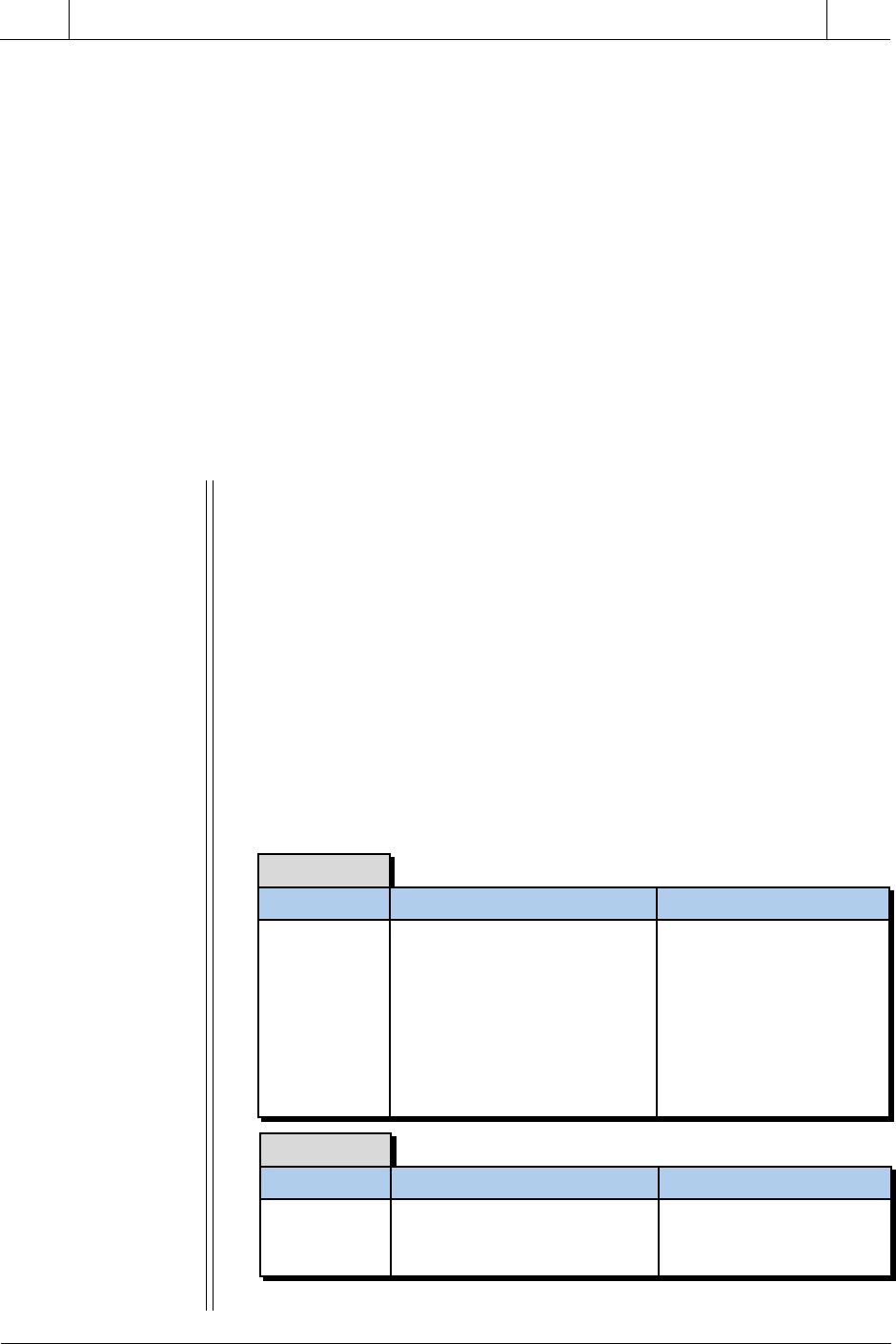
780
SECTION
5
Advanced PLC
Topics and Networks
Industrial Text & Video Company 1-800-752-8398
www.industrialtext.com
CHAPTER
16
Artificial Intelligence
and PLC Systems
A slightly different degree of complexity occurs in a rule-based knowledge
representation when the rule has several probable causes. For example:
IF volume drops, THEN
valve failure
or
pump failure
or
feedback failure
In this case, the consequents must be further investigated to arrive at a
complete formal rule. The inference engine can use the consequents derived
in the knowledge representation to obtain a better definition of the problem’s
cause. Knowledge and expert AI systems use this process to provide ad-
vanced decision-making capabilities.
EXAMPLE 16-1
A PLC-controlled box conveyor transports two sizes of boxes that are
diverted to different palletizer operations according to their size. A
solenoid activates the diverter that sorts the boxes. Write the rules that
a knowledge database could use to detect a possible cause for the
solenoid’s malfunction.
Figure 16-3. Knowledge database rules for conveyor fault.
SOLUTION
One of two factors can result in solenoid failure according to the
situation presented: coil burnout or mechanical damage. The condi-
tions and causes in Figure 16-3 describe these two possible factors
that could lead to a fault.
Rule #1
Result
Burned-out coil
Condition Cause
Excessive temperature is
developed due to continuous
high-current input
—Low line voltage causes
failure to pull plunger
—High ambient
temperature
—Mechanically blocked
plunger
—Operations too rapid
Rule #2
Result
Mechanical
damage
Condition Cause
Excessive force exerted on
the plunger
—Overvoltage
—Reduced load

781
CHAPTER
16
Artificial Intelligence
and PLC Systems
SECTION
5
Advanced PLC
Topics and Networks
Industrial Text & Video Company 1-800-752-8398
www.industrialtext.com
16-5 KNOWLEDGE INFERENCE
Knowledge inference is the methodology used for gathering and analyzing
data to draw conclusions. Knowledge inference occurs in the inference engine
during the execution of the main control strategy program. It also occurs in
the knowledge database during the comparison and computation of rule
solutions.
The system’s software program determines the approach used to derive AI
solutions. Operator interaction on control problems can enhance the solu-
tion-finding process. For example, if the system detects a failure due to a
misreading in an inspection system, it may alert the operator to the problem
and advise him/her of probable causes. Furthermore, the system may wait for
the operator’s input (e.g., check for laser intensity in the receiver side to
determine if the laser beam is reflecting at the correct angle) and then use the
operator’s input to develop more intelligent solutions to the problem.
In small systems, knowledge inference occurs on a local basis. That is, the
control system houses the resident software for the inference engine. In large,
distributed, intelligent systems, knowledge inference often occurs at a main
host in the hierarchical system.
Remember that the degree of AI involvement in the system will determine
how much hardware is required (e.g., computer modules, powerful PLCs,
small PLCs with personal computers, etc.). When all global databases are in
constant network communication, allowing knowledge inference informa-
tion to be passed from one controller to another, the intelligent system is said
to have a blackboard architectural structure.
In all types of intelligent systems, certain methods of rule evaluation are
used to implement knowledge inference. These methods include forward
chaining and backward chaining. Intelligent systems also analyze statistical
information as part of knowledge inferencing to obtain predictions about
outcomes.
BLACKBOARD ARCHITECTURE
Large, complex, distributed control systems involve the interaction of several
subsystems, which continuously communicate with each other either directly
or over a local area network. When artificial intelligence is added to these
large systems, system elements, such as knowledge inferencing and the
global and knowledge databases, are distributed throughout the architecture
of the control system. Whether or not each of the controllers in the network
has a local inference engine, global database, and knowledge database
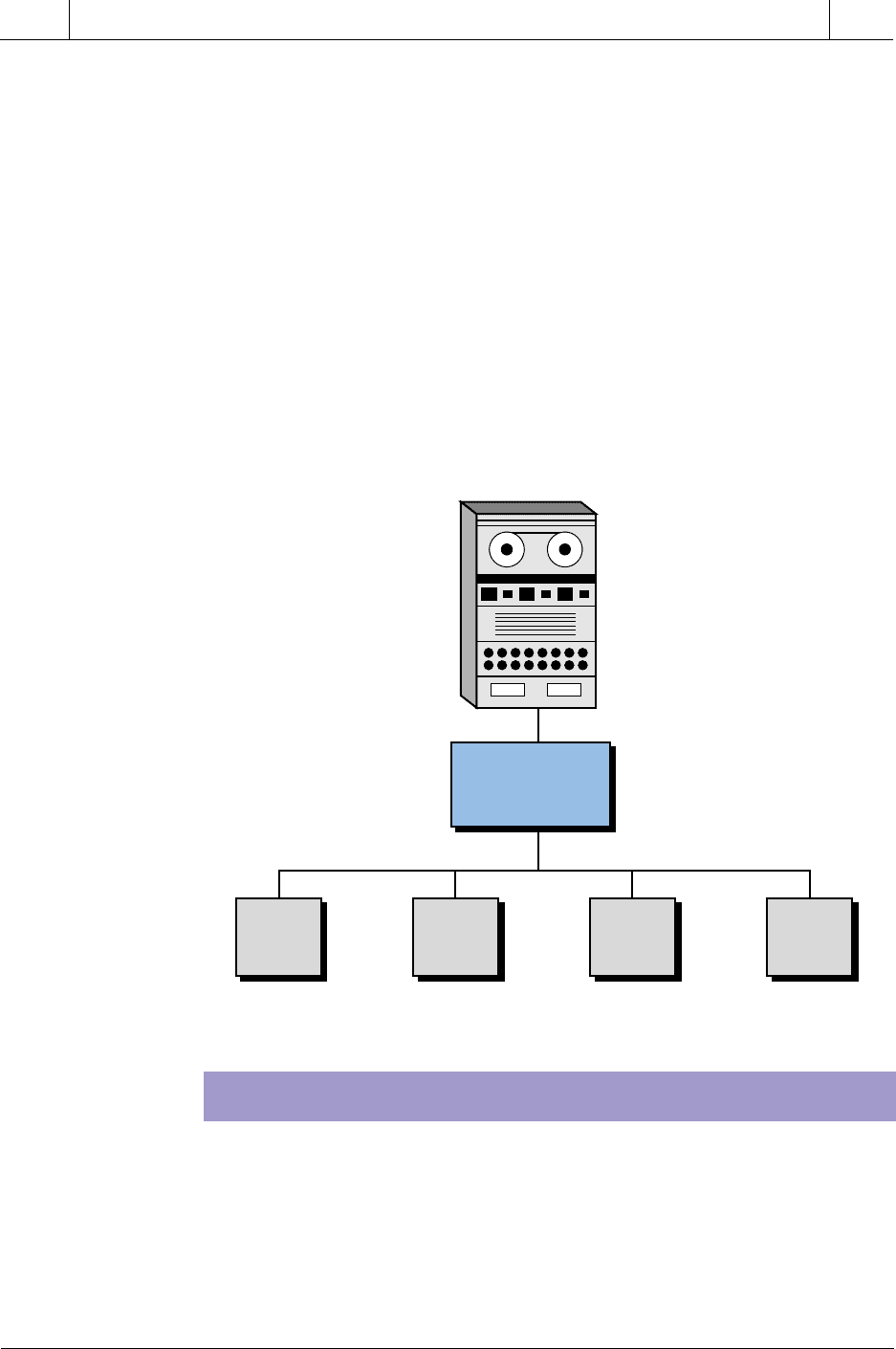
782
SECTION
5
Advanced PLC
Topics and Networks
Industrial Text & Video Company 1-800-752-8398
www.industrialtext.com
CHAPTER
16
Artificial Intelligence
and PLC Systems
depends on the degree of inferencing that occurs on a local basis. Blackboard
architecture is the name given to this type of large system, which utilizes
several subsystems containing local global and knowledge databases.
Figure 16-4 illustrates a blackboard configuration of an intelligent control
system. The PLCs at the subsystem level may contain computer modules,
which help them perform inference engine computations. The hierarchy of
the control system allows the supervisory PLC controller to poll each of the
subsystems and obtain all or part of their local global database information.
The host computer element in this control structure holds the blackboard, the
area that stores all of the information obtained from the subsystems by the
supervisory PLC. The inference engine of the host element then implements
the complex AI solution according to its knowledge inference about the total
control system.
Figure 16-4. Example of blackboard architecture.
FORWARD CHAINING
Forward chaining is a method used to determine possible outcomes for
given data inputs. Forward chaining inference engines typically receive
process information via the global database and monitor specific inputs to the
control system to determine the outcomes. For instance, in Example 16-1,
forward chaining specifies the following consequences for a failed solenoid:
a jammed conveyor or misplaced boxes in the two palletizers.
Host
Computer
System
Blackboard
• Inference engine
• Global database
• Knowledge database
Local (PLC Systems)
• Inference engine
• Global database
• Knowledge database
Local (Supervisory PLC)
• Inference engine
• Global database
• Knowledge database
Supervisory
PLC System
PLC
System
PLC
System
PLC
System
PLC
System
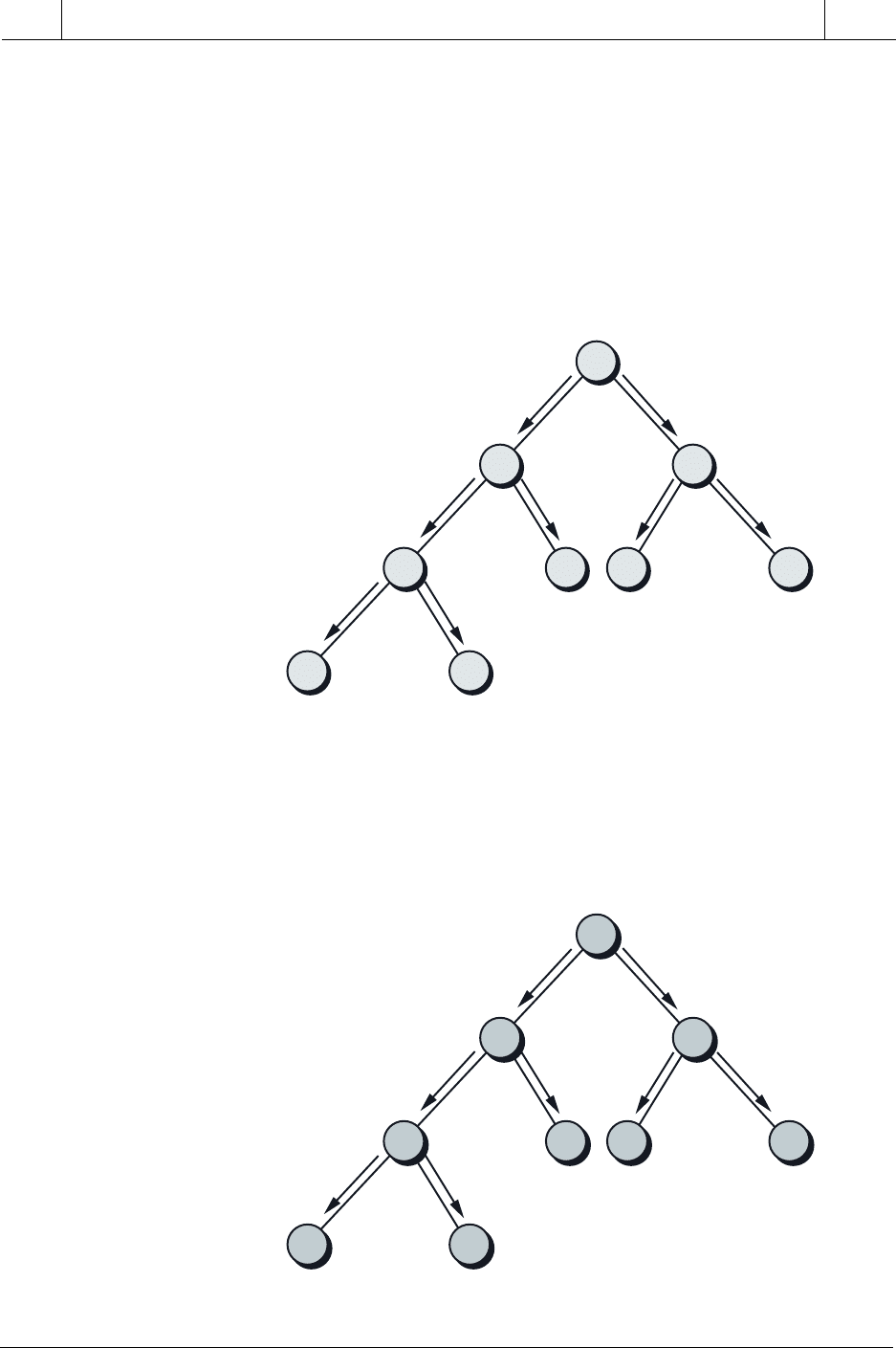
783
CHAPTER
16
Artificial Intelligence
and PLC Systems
SECTION
5
Advanced PLC
Topics and Networks
Industrial Text & Video Company 1-800-752-8398
www.industrialtext.com
Two different types of fact searching occur within the forward chaining
method: depth first and breadth first. Both searches deal with how the
outcome is obtained. A depth-first search, shown in Figure 16-5, evaluates
the rules that form the knowledge database (A, B, C, etc.) on a priority basis
going down the tree. In the conveyor example mentioned earlier, when the
control system detects the solenoid failure (A), it will evaluate a new rule to
see if jamming has occurred (B). If the conveyor has jammed, then the system
will evaluate the consequences that can occur (e.g., material inside box may
break or material could spill (D)).
1
2
3 4
5
6
8
7
A
C
F G
B
ED
IH
Figure 16-5. Forward chaining depth-first search.
In contrast, the breadth-first method evaluates each rule in the same level of
the tree before proceeding to the next level down (see Figure 16-6). In our
conveyor example, a breadth-first evaluation of the rules means that after
the solenoid failure (A) the system will check for a possible jam (B), then it
will check for palletizer misplacement (C), and so on.
A
C
F G
B
ED
IH
1
3
7 8
4
2
6
5
Figure 16-6. Forward chaining breadth-first search.

784
SECTION
5
Advanced PLC
Topics and Networks
Industrial Text & Video Company 1-800-752-8398
www.industrialtext.com
CHAPTER
16
Artificial Intelligence
and PLC Systems
BACKWARD CHAINING
STATISTICAL AND PROBABILITY ANALYSIS
EXAMPLE 16-2
A control system monitors and controls a cooker in a temperature loop
with specifications as shown in Figure 16-7. Indicate how AI can be
added to the system to detect real temperature problems. Also,
indicate how the system can screen out false temperature faults.
Backward chaining is a method for finding the causes of an outcome.
Referring to Example 16-1, the rule tables present backward chaining
information—that is, causes for the solenoid failure outcome. Basically,
backward chaining analyzes the consequences to obtain the antecedents.
Similar to forward chaining, backward chaining uses both the depth-first and
breadth-first search methods. In our conveyor example, after the solenoid
failure occurs, a backward chaining depth-first search will first check one
condition rule then check each possible cause of that condition. On the other
hand, a breadth-first search will first examine both of the condition rules and
then obtain the causes for each of the conditions.
Statistical analysis and probability play a large role in artificial intelligence
systems. These aspects of AI are particularly important in expert systems,
which predict outcomes. The system’s global database stores the process
information that will be used in the AI statistical analysis.
In Chapter 13, we explained how to interpret and obtain statistical data,
such as the mean, mode, median, and standard deviation. These statistical
computations help determine a future outcome based on what is happening in
the current process. Decisions based on statistics can be related to the
consequences of the rules described in the knowledge representation. For
example, just because a system detects an error fault does not mean that the
fault actually occurred, even though the feedback data transducer devices
may be operating correctly. Using statistical analysis, the inference engine
may decide not to advise personnel or apply the corresponding control to the
fault, but instead to continue monitoring the situation more closely.
SOLUTION
Figure 16-7a shows a profile of temperature readings from the
system. The PLC can monitor and accumulate temperature data
continuously from time
t
0
to time
t
1
using FIFO instructions, storing this
data in a storage area with a fixed number of registers (see Figure 16-
7b). The program can also compute the mean, median, and standard
deviation of the current temperature readings.
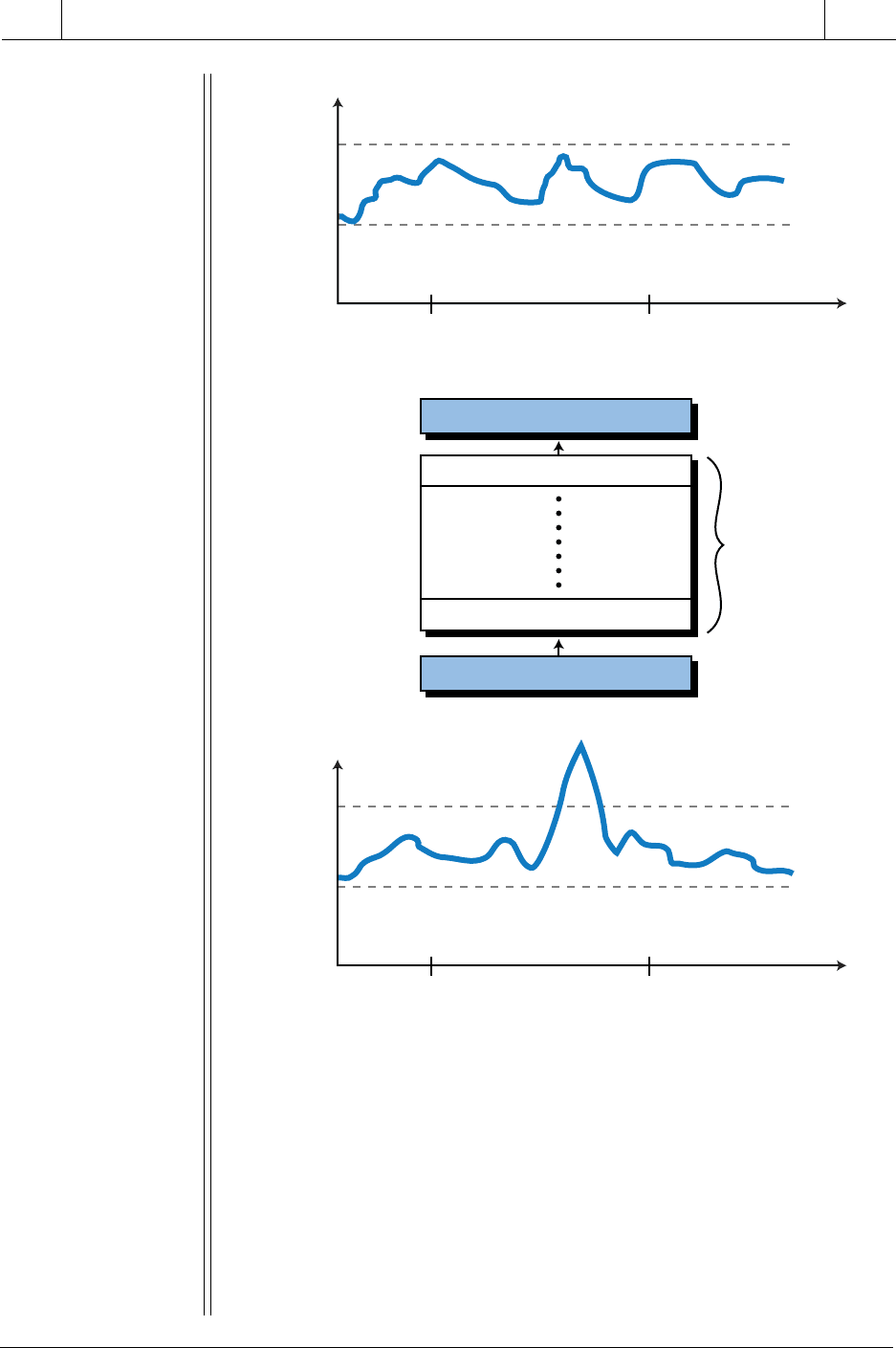
785
CHAPTER
16
Artificial Intelligence
and PLC Systems
SECTION
5
Advanced PLC
Topics and Networks
Industrial Text & Video Company 1-800-752-8398
www.industrialtext.com
If a high-limit alarm occurs (see Figure 16-7c), a normal system would
control the cooker by adjusting its temperature loop. However, the
temperature fault may not have been caused by a temperature loop
malfunction; a noise spike near the temperature transducer could
have caused it.
An intelligent system would detect this sudden temperature increase
by recognizing that it is well beyond the mean and median of the
readings for the
t
0
to
t
1
period, therefore exhibiting a large standard
Figure 16-7. (a) Profile of temperature readings, (b) FIFO storage method, and (c)
high-limit alarm value in the example process.
High Limit
Low Limit
Time
Temperature
°C
Time
°C
t
0
t
1
High Limit
Low Limit
Time
Temperature
°C
t
0
t
1
Temperature Out
Temperature In
(a)
(b)
(c)
Temperature at time
t
1
Temperature at time
t
0
Temperature
values stored

786
SECTION
5
Advanced PLC
Topics and Networks
Industrial Text & Video Company 1-800-752-8398
www.industrialtext.com
CHAPTER
16
Artificial Intelligence
and PLC Systems
PX Y
PY X PX
PY X PX PY X PX
(/)
[ ( / )][ ( )]
[ ( / )][ ( )] [ ( / )][ ( )]
=
+
where:
PY X Y X
PX X
PY X Y X
PX X
(/)
()
(/ )
()
=
=
=
=
the probability that occurs when has occurred
the prior probability that has occurred
the conditional probability that occurs if does not occur
the prior probability that has not occurred
deviation. By implementing a rule that considers the statistics of the
process, the AI system will ignore the false alarm and not add the
temperature reading value to the average calculations report. Further-
more, the global database of the system will receive information, for
future use, about the time of day, location, and level of the spike
reading. The system will closely analyze the temperature increase in
case it is a true alarm. It will use temperature rate of change compu-
tations to help determine if it is a true fault.
Probability can be useful when determining or approximating the possible
cause of a fault in a diagnostic ruling. One of the most commonly used
probability methods is Baye’s theorem of conditional probability. The use
of this type of probability in an AI system is known as conditional
probability inferencing. To employ probability computations in any system,
however, the system must maintain historical information about the process.
The expert generally provides this type of data.
Baye’s theorem defines the probability of X event occurring based on the
fact that Y has already occurred [P(X/Y)] as:
EXAMPLE 16-3
Part of a conveyor system controls a solenoid-operated diverter,
which sends two types of boxes to two different repackaging areas.
The system uses several photoelectric eyes to determine which box
goes where.
The material-handling expert indicates that, due to the size and type
of the boxes and environment, the following probabilities exist for
conveyor faults:
For a solenoid-caused fault:
• The prior probability of a solenoid fault is 20% (80%
probability that it does not fault).

787
CHAPTER
16
Artificial Intelligence
and PLC Systems
SECTION
5
Advanced PLC
Topics and Networks
Industrial Text & Video Company 1-800-752-8398
www.industrialtext.com
• The probability that the boxes will go to the right place
when the solenoid is faulty is 35%.
• The probability that the boxes will go to the right place
when the solenoid is good is 60%.
For a photoeye-caused fault:
• The probability of a photoeye fault is 35% (65% prob-
ability that it does not fault).
• The probability that the boxes go to the right place when
the eye is faulty is 25%.
• The probability that the boxes go to the right place when
the eye is good is 45%.
Find the most probable cause of a conveyor fault when the boxes are
going to the right place.
SOLUTION
We can include the expert’s data in the knowledge representation by
calculating which element has a higher percentage probability of
having occurred. Using Baye’s theorem, the probability that the solenoid
is faulty (
S
) even though the boxes are going to the right place (
B
) is:
PS B
PB S PS
PB S PS PB S PS
(/)
[ ( / )][ ( )]
[ ( / )][ ( )] [ ( / )][ ( )]
(. )(. )
(. )(. ) (. )(. )
.%
=
+
=
+
=
035 020
035 020 060 080
12 73
The probability that the photoeye is faulty (
E
) even though the boxes
are going to the right place (
B
) is:
PE B
PB E PE
PB E PE PB E PE
(/)
[ ( / )][ ( )]
[ ( / )][ ( )] [ ( / )][ ( )]
(. )(. )
(. )(. ) (. )(. )
.%
=
+
=
+
=
025 035
025 035 045 065
23 03
The computations indicate that a photoeye fault is most likely to have
occurred in the conveyor system. In this event, the operator should be
alerted and the system temporarily halted. Also, the global database
should be updated with the statistics of the fault occurrence, so that
this information can be used in the future.
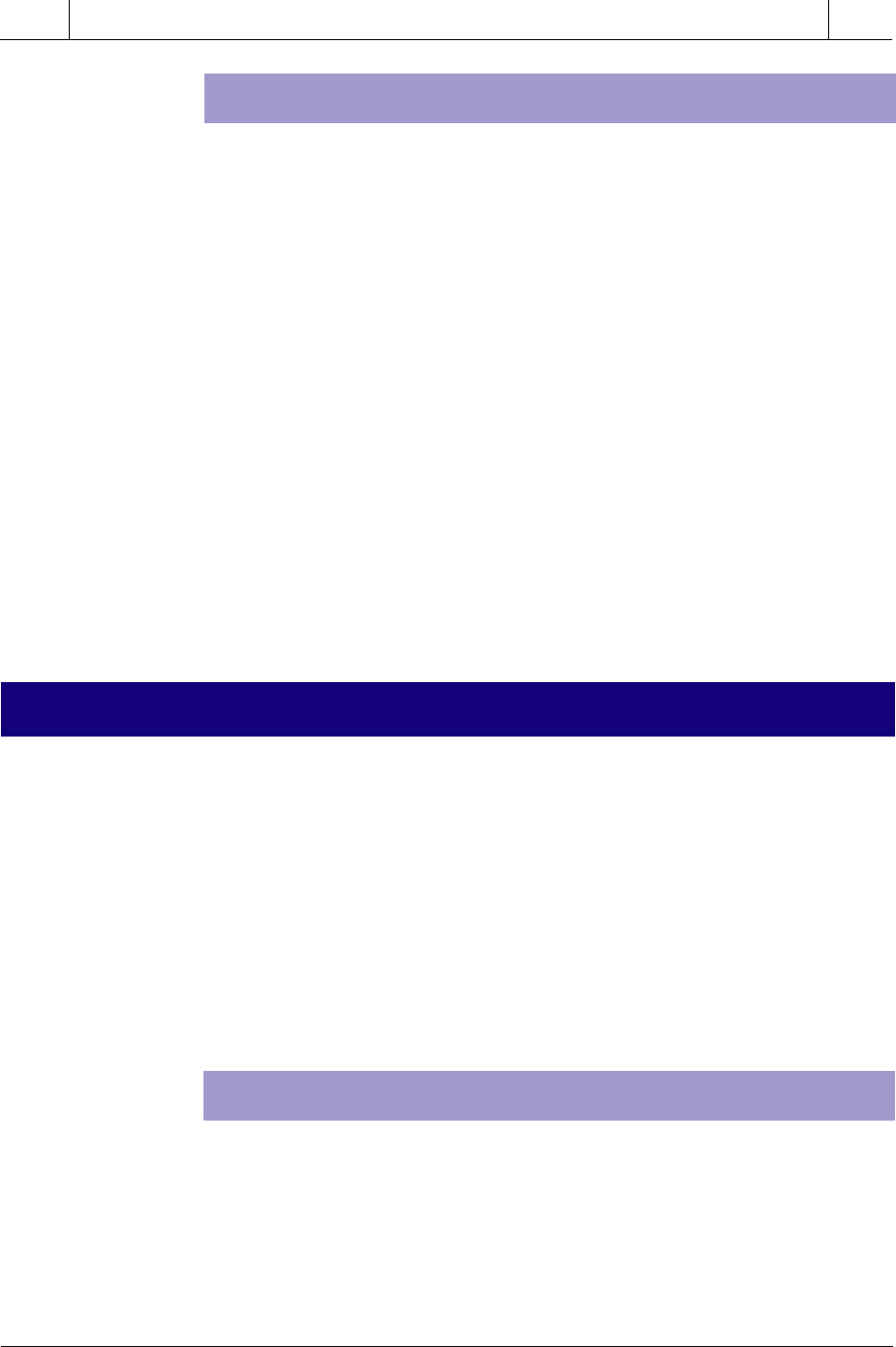
788
SECTION
5
Advanced PLC
Topics and Networks
Industrial Text & Video Company 1-800-752-8398
www.industrialtext.com
CHAPTER
16
Artificial Intelligence
and PLC Systems
CONFLICT RESOLUTION
A conflict occurs when more than one rule is triggered at the same time in an
AI system. Normally, a system starts executing rules based on the order of
occurrence of the situation. However, when situations happen at the same
time, a conflict may occur in the system. For example, a system may receive
information indicating that a high temperature, a low pressure, and a flow
obstruction have all occurred. These three situations, on their own or in
combination, can trigger the following rule consequents:
Rule 1: IF high temperature, THEN start cooling procedure.
Rule 2: IF low pressure and flow obstruction, THEN open
relief valve in main supply pipe.
Rule 3: IF high temperature and low pressure, THEN open
relief valve in main supply pipe and alert personnel in
the area.
Therefore, the system must make a decision about which of these three rules
to implement. It must select the rule that exhibits the greater priority—in this
case, rule 3. The expert provides the system with this information about the
priority of rule execution.
The example presented in this section illustrates the use of the methodology
described in the previous sections. For simplicity, we will not elaborate on the
PLC program coding for the application, but we will describe the rules used
to define the knowledge representation.
The AI setup in this example is a diagnostic-level system implemented by a
PLC-based control system. The method of rule evaluation is backward
chaining (i.e., once the system detects a fault, it searches for the cause of the
fault). In the batching system, the control program implements AI fault
detection for only one of the two ingredients. The rules for the second
ingredient are similar to the first ingredient.
DEFINITION OF THE PROCESS
Two ingredients, A and B, are to be mixed in the tank of the batching system
shown in Figure 16-8. Figures 16-9 through 16-12 show the flowcharts of the
process, as well as the steam valve–versus–temperature relationships. The
process is as follows:
• A flow meter counts the number of pulses to monitor the amount of
the ingredients in the tank (in gallons).
16-6 AI FAULT DIAGNOSTICS APPLICATION
